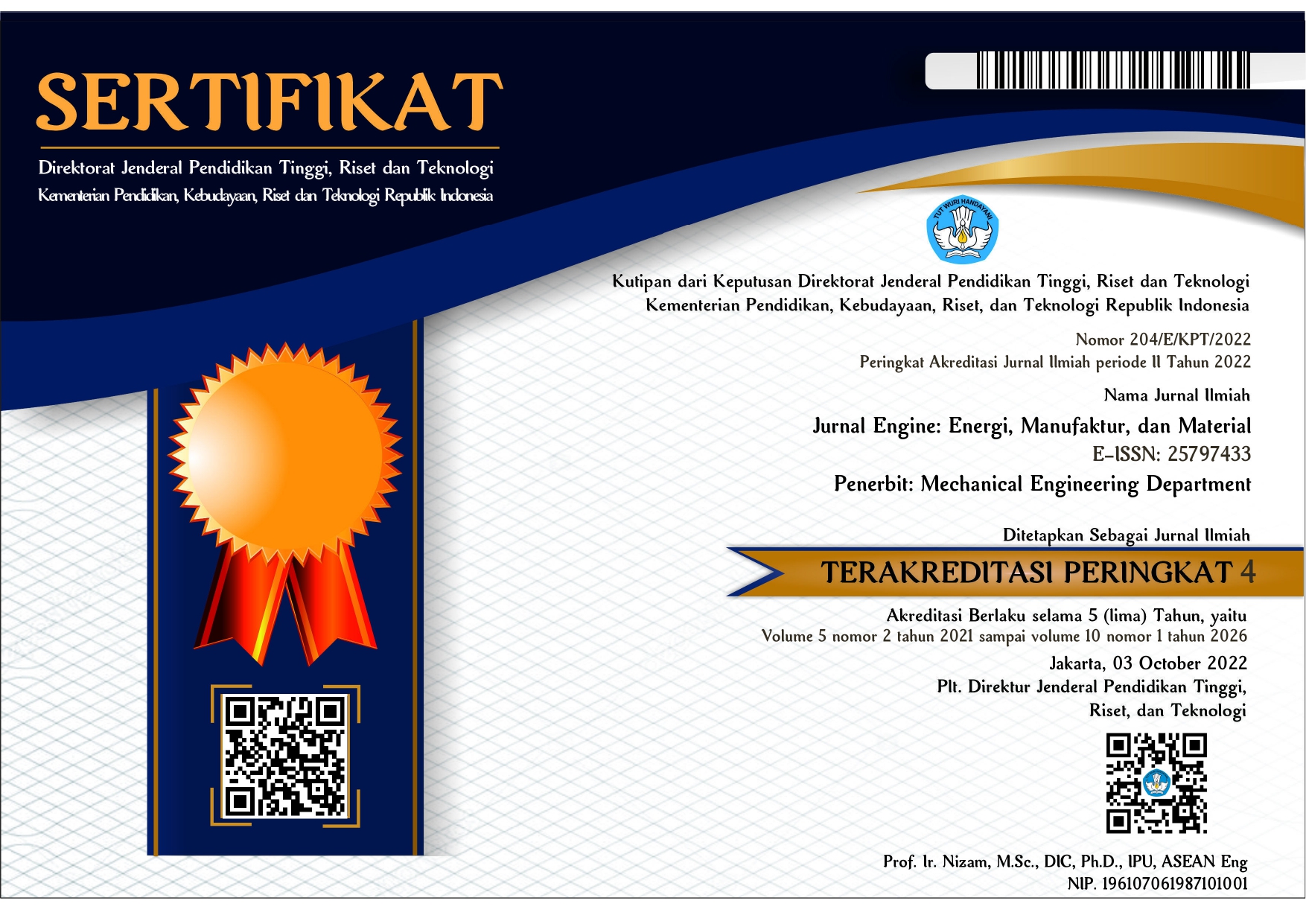Pengujian Kekuatan Retak Komposit Arang Tempurung yang Dihaluskan Sebagai Bahan Baku Penganti Kayu untuk Kapal Nelayan
DOI:
https://doi.org/10.30588/jeemm.v8i1.1633Abstract
Coconut shell charcoal is a by-product waste from coconut farming which is very abundant and its use has not been optimally applied other than being limited to burning it for boiler energy as a heater and other parts of it being used as a fuel source for cooking. As raw materials for making wooden boats for fishermen in Indonesia become increasingly scarce, efforts are needed to find replacement materials in the supply process. However, another very urgent factor is that it is absolutely necessary to develop environmentally friendly composites to replace synthetic composites which are difficult to decompose. However, composite materials made from natural fibers still have many weaknesses, including low mechanical strength, therefore applications in the engineering field are still under study and development. Some of the weaknesses of natural fiber composite materials, which need to be studied, include their brittle nature and easy cracking. One of the things carried out in this research is a synthetic material derived from unsaturated polyester reinforced with natural fibers from coconut shell charcoal particles which is used to reduce the percentage of synthetic material from polyester which can form a composite that is easily decomposed. From the research, the mechanical strength obtained with a polyester mixture matrix reinforced with coconut shell charcoal fibers obtained crack resistance values with a large critical stress intensity factor based on ASTM D 5405 by varying the composition of the shell charcoal fiber mixture from: 0%, 10%, 20%, to 30%. From the test results, the largest critical stress intensity factor at K_1c= 1.624 (MPa/m1/2) occurred in 20% coconut shell charcoal fiber.
References
N. Hiremath, S. Young, H. Ghossein, D. Penumadu, U. Vaidya, and M. Theodore, “Low cost textile-grade carbon-fiber epoxy composites for automotive and wind energy applications,” Compos. Part B Eng., vol. 198, no. May, p. 108156, 2020, doi: 10.1016/j.compositesb.2020.108156.
M. Davallo, H. Pasdar, and M. Mohseni, “Mechanical properties of unsaturated polyester resin,” Int. J. ChemTech Res., vol. 2, no. 4, pp. 2113–2117, 2010.
N. Nusyirwan et al., “Methods for increasing fracture toughness of thermosetting polyester polymers with vinyl ester mixtures as raw materials for automotive components,” Indian J. Eng., vol. 20, no. 53, pp. 1–10, 2023, doi: 10.54905/disssi/v20i53/e20ije1648.
and D. H. H. Abral, R. Fajrul, M. Mahardika, “Improving impact, tensile and thermal properties of thermoset unsaturated polyester via mixing with methyl merhacrylate and thermoset vinyl ester,” 2019.
D. Frómeta et al., “Identification of fracture toughness parameters to understand the fracture resistance of advanced high strength sheet steels,” Eng. Fract. Mech., vol. 229, no. February, p. 106949, 2020, doi: 10.1016/j.engfracmech.2020.106949.
N. Nusyirwan, P. Abiema, and A. Malik, “Methods Increased Fracture Toughness Thermosetting Polyester Mixture with Vi- nyl Ester for Raw Materials in Ship Bodies,” vol. 1, no. 1, pp. 43–50, 2023.
N. Nusyirwan and S. Ilham, “Study of Improving Fracture Toughness of Un-Saturated Polyester with Addition of Mixing Percentage of CPO Oils,” vol. 2, pp. 132–137, 2022.
H. Adam, “Carbon fibre in automotive applications,” Mater. Des., vol. 18, no. 4–6, pp. 349–355, 1997, doi: 10.1016/s0261-3069(97)00076-9.
N. Adnan, H. Abral, D. H, and E. Staria, “Identification of Mechanical Strength for Mixture of Thermoset Polyester with Thermoset Vinyl Ester due to Bending Load,” JMPM (Jurnal Mater. dan Proses Manufaktur), vol. 6, no. 1, pp. 19–25, 2022, doi: 10.18196/jmpm.v6i1.14450.
N. Adnand, R. Mutya, F. Ridwan, H. Abral, H. Dahlan, and E. Satria, “Pengaruh Variasi Persentase Campuran Polymer Polyester dan Vinyl Ester Terhadap Kekuatan Tegangan Lentur,” Met. J. Sist. Mek. dan Termal, vol. 5, no. 2, p. 126, 2021, doi: 10.25077/metal.5.2.126-131.2021.
Nusyirwan, F. Yande, H. Abral, Ihamdi, H. Dahlan, and E. Satria, “Effect of variations in load speed on fracture toughness of thermoset polyester/thermoset vinyl ester blend,” AIP Conf. Proc., vol. 2592, no. March 1996, 2023, doi: 10.1063/5.0115043.
P. K. Naik, N. V. Londe, B. Yogesha, L. Laxmana Naik, and K. V. Pradeep, “Mode i Fracture Characterization of Banana Fibre Reinforced Polymer Composite,” IOP Conf. Ser. Mater. Sci. Eng., vol. 376, no. 1, 2018, doi: 10.1088/1757-899X/376/1/012041.
H. Ardhyananta et al., “Mechanical and Thermal Properties of Unsaturated Polyester/Vinyl Ester Blends Cured at Room Temperature,” IOP Conf. Ser. Mater. Sci. Eng., vol. 202, no. 1, 2017, doi: 10.1088/1757-899X/202/1/012088.
Nusyirwan, H. Abral, M. Hakim, and R. Vadia, “The potential of rising husk fiber/native sago starch reinforced biocomposite to automotive component,” IOP Conf. Ser. Mater. Sci. Eng., vol. 602, no. 1, 2019, doi: 10.1088/1757-899X/602/1/012085.
A. T. Seyhan, M. Tanoǧlu, and K. Schulte, “Tensile mechanical behavior and fracture toughness of MWCNT and DWCNT modified vinyl-ester/polyester hybrid nanocomposites produced by 3-roll milling,” Mater. Sci. Eng. A, vol. 523, no. 1–2, pp. 85–92, 2009, doi: 10.1016/j.msea.2009.05.035.
Z. Yang, H. Peng, W. Wang, and T. Liu, “Crystallization behavior of poly(ε-caprolactone)/layered double hydroxide nanocomposites,” J. Appl. Polym. Sci., vol. 116, no. 5, pp. 2658–2667, 2010, doi: 10.1002/app.
H. Abral et al., “Improving impact, tensile and thermal properties of thermoset unsaturated polyester via mixing with thermoset vinyl ester and methyl methacrylate,” Polym. Test., vol. 81, no. August 2019, p. 106193, 2020, doi: 10.1016/j.polymertesting.2019.106193.
A. Budiman and S. Sugiman, “Karakteristik Sifat Mekanik Komposit Serat Bambu Resin Polyester Tak Jenuh Dengan Filler Partikel Sekam,” Din. Tek. Mesin, vol. 6, no. 1, pp. 76–82, 2016, doi: 10.29303/d.v6i1.28.
H. Abral et al., “Nanovoids in fracture surface of unsaturated polyester/vinyl ester blends resulting from disruption of the cross-linking of the polymer chain networks,” IOP Conf. Ser. Mater. Sci. Eng., vol. 1062, no. 1, 2021, doi: 10.1088/1757-899X/1062/1/012051.
S. Jeyanthi and J. Janci Rani, “Improving mechanical properties by KENAF natural long fiber reinforced composite for automotive structures,” J. Appl. Sci. Eng., vol. 15, no. 3, pp. 275–280, 2012, doi: 10.6180/jase.2012.15.3.08.
Q. Meng and T. Wang, “An improved crack-bridging model for rigid particle-polymer composites,” Eng. Fract. Mech., vol. 211, no. January, pp. 291–302, 2019, doi: 10.1016/j.engfracmech.2019.02.028.
H. N. Dhakal and S. O. Ismail, Unsaturated polyester resins: Blends, interpenetrating polymer networks, composites, and nanocomposites. Elsevier Inc., 2019. doi: 10.1016/B978-0-12-816129-6.00008-9.
K. Liu, S. He, Y. Qian, Q. An, A. Stein, and C. W. Macosko, “Nanoparticles in Glass Fiber-Reinforced Polyester Composites: Comparing Toughening Effects of Modified Graphene Oxide and Core-Shell Rubber,” Polym. Compos., vol. 40, no. S2, pp. E1512–E1524, 2019, doi: 10.1002/pc.25065.
N. Nusyirwan, A. Peronika, H. Abral, H. Dahlan, E. Satria, and A. Sutanto, “Unsaturated Polyester Fracture Toughness Mechanism With Blending To Vinyl Ester and Mma,” ARPN J. Eng. Appl. Sci., vol. 17, no. 23, pp. 1990–1996, 2022.
N. Nusyirwan, M. Rani, and R. Pratama, “Identification of the fracture surface of thermoset polyester due to bending load,” vol. 7, no. 1, pp. 51–58, 2022, doi: 10.22219/jemmme.v7i1.23086.
Downloads
Additional Files
Published
How to Cite
Issue
Section
License
Authors who publish with Jurnal Engine: Energi, Manufaktur, dan Material agree to the following terms:
Authors retain copyright and grant the Jurnal Engine: Energi, Manufaktur, dan Material right of first publication with the work simultaneously licensed under a Creative Commons Attribution 4.0 International License that allows others to share (copy and redistribute the material in any medium or format) and adapt (remix, transform, and build upon the material) the work for any purpose, even commercially with an acknowledgment of the work's authorship and initial publication in Jurnal Engine: Energi, Manufaktur, dan Material. Authors are able to enter into separate, additional contractual arrangements for the non-exclusive distribution of the journal's published version of the work (e.g., post it to an institutional repository or publish it in a book), with an acknowledgment of its initial publication in Jurnal Engine: Energi, Manufaktur, dan Material. Authors are permitted and encouraged to post their work online (e.g., in institutional repositories or on their website) prior to and during the submission process, as it can lead to productive exchanges, as well as earlier and greater citation of published work (See The Effect of Open Access).


















